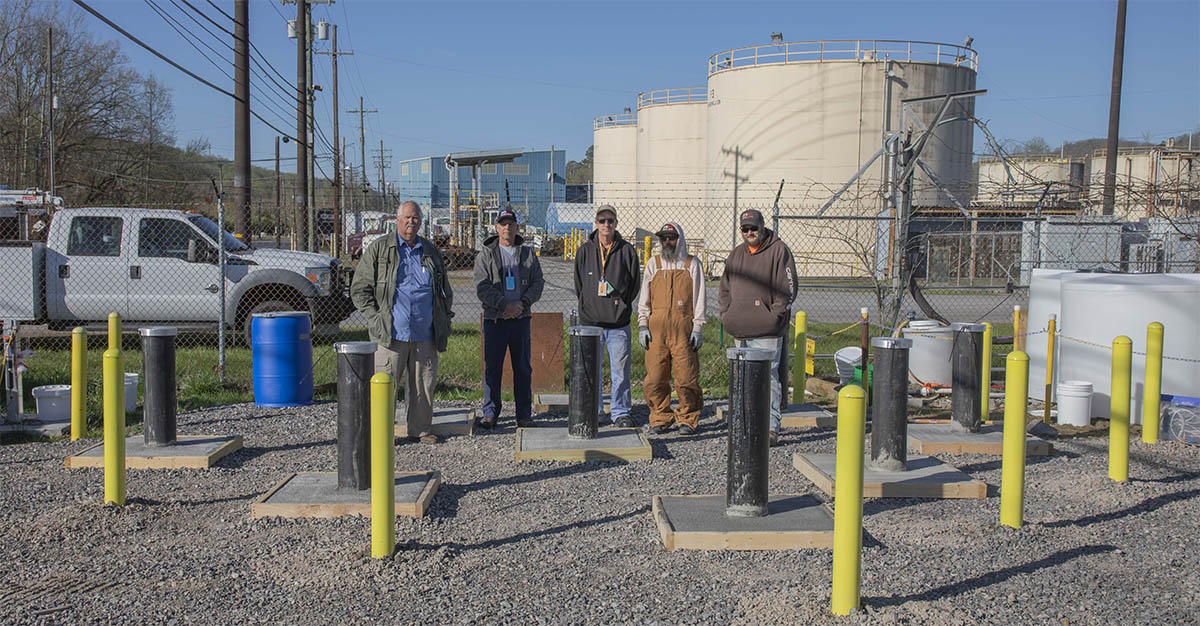The Y-12 National Security Complex first began refining uranium during World War II, nearly 80 years ago. The complex grounds are steeped in history—and in something less savory.
“They washed used nuclear reactor fuel rods with nitric acid, then dumped that waste fluid into the four unlined S-3 Waste Disposal Ponds,” said Terry C. Hazen, the UT-Oak Ridge National Laboratory (ORNL) Governor’s Chair for Environmental Biotechnology. “They dumped literally millions of gallons a year into each of these ponds for almost 30 years.”
The S-3 Ponds were used from 1951 to 1983, when they were neutralized and paved over to create a parking lot that is still in use. However, the ponds’ contaminated contents continued mixing with the groundwater that flows under the surface of the site.
In addition to uranium, acids, and metals, the ponds are leaking nitrate, which can lead to low blood oxygen levels when ingested. The US Environmental Protection Agency considers nitrate concentrations above 10 parts per million (ppm) unsafe to drink.
“We’ve seen as high as 30,000 ppm of nitrate in Y-12 groundwater,” said Hazen. “This site has the highest concentrations of groundwater nitrates in the world.”
Surprisingly, however, Hazen discovered years ago that the contaminated water hosts a thriving microbial community—which presents an interesting opportunity.
“The Office of Science at the US Department of Energy (DOE) is interested in how extreme environments affect biogeochemistry, the ability for normal biological and geological reactions to occur under the ground’s surface,” Hazen said.

From left to right: Terry Hazen, Joel Miller (ORNL), Dan Williams (UT), Mark Daugherty (M&W Drilling), and Jim Javins (M&W Drilling) pose with the completed SSO at Y-12 on March 29, 2023. Black posts mark the nine wells of the SSO.
That interest fuels Ecosystems and Networks Integrated with Genes and Molecular Assemblies (ENIGMA), a DOE Science Focus Area managed by Lawrence Berkeley National Laboratory (LBNL) that coordinates 16 principal investigators across 11 US institutions. By pooling their expertise in environmental and laboratory biology and modeling, the ENIGMA researchers hope to develop a model that accurately predicts how microbial communities affect critical ecosystem processes at Y-12.
Hazen, who co-founded the original team at LBNL in 2001, recently oversaw the installation of a new suite of instruments that will revolutionize ENIGMA’s research.
The system, called the SubSurface Observatory (SSO), is a grid of nine wells near the S-3 Ponds. Each well has at least four subwells, reaching 25 to 35 feet down, which are lined with screened PVC pipes to allow the free movement of air and water.
“Each subwell has a sensor that constantly reports the temperature, oxygen and nitrate concentration, acidity, and a variety of other things,” said Hazen. “The beauty of this SSO is that we will be able to monitor all nine sets of wells out there, at multiple depths, and all that information is immediately uploaded, encrypted, and sent to me and the other ENIGMA members.”
Hazen and his team will also regularly pull microbial samples from the wells, evaluating total biomass as well as the species—and even genes—that are most common at each depth.
“It’s a systems approach to microbial ecology,” Hazen said. “We’re utilizing the scientific expertise of the whole ENIGMA team and taking advantage of knowing exactly what’s going on with all these different factors.”
That unprecedented level of detail has attracted a lot of attention. The ENIGMA team will be balancing a $12 million annual budget to run experiments for multiple universities and national laboratories. One of the team’s first goals is to unravel the mystery of the nitrate levels.
“I’m trying to understand why we still see such high levels of nitrate in the immediate groundwater 30 years after the dumping ended,” said Hazen. “Can we develop a systems approach so we better understand what’s controlling those levels?”
The answer could be useful in cleaning up not just other nuclear refinement sites, but agricultural areas, where high rates of nitrate fertilizer application can devastate aquatic ecosystems.
“The most exciting part of this SSO is how much it improves our ability to understand a system,” Hazen said. “I want to demonstrate that by using geological studies in combination with an SSO, we could show the best way to remediate any site—to clean it up long term.”
Contact
Izzie Gall (865-974-7203, egall4@utk.edu)
